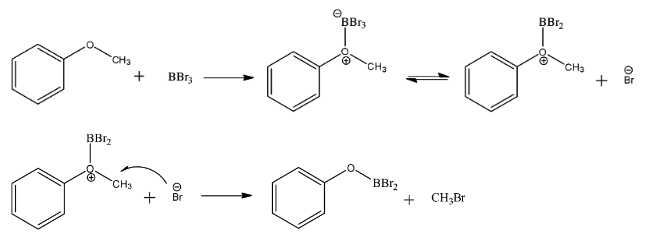Answer
37.2k+ views
Hint: Think about what will happen when boron tribromide reacts with an ether. After boron tribromide has caused cleavage of the ether, hydrolysis occurs and the products are formed.
Complete step by step solution:
Boron tribromide is a reagent that is used to cause the cleavage of dialkyl ether to form an alcohol, boric acid and alkyl bromide. This is a two-step reaction and requires boron tribromide in the first step and hydrolysis with water in the second step. The reaction mechanism is as follows:
i) One mole of phenyl methyl ether reacts with one mole of $BB{{r}_{3}}$ to give an intermediate complex that has benzene bonded to an oxygen atom which is further bonded to boron and two bromine atoms. It also gives a mole of methyl bromide as a byproduct.

ii) This complex can only be converted to a phenol, which is the aim of the reaction, if it is hydrolyzed by three molecules of water. Two molecules of water first hydrolyze the bonds between boron and bromine, the hydrogen proton is taken by bromine and the hydroxide ion attacks the boron atom. The remaining hydrogen atom hydrolyzes the bond between oxygen and boron where boron gets the hydroxide ion and oxygen the hydrogen proton. The reaction is as follows:
\[PhOBB{{r}_{2}}+3{{H}_{2}}O\to PhOH+{{H}_{3}}B{{O}_{3}}\]
Hence, the three products that are formed after this reaction are phenol, boric acid, and methyl bromide.
Note: The products formed that we are considering here are all the products that we will find in the vessel of the reaction after both the reagents have been added. We will consider the net products obtained and not just the ones formed in only the first or the second step.
Complete step by step solution:
Boron tribromide is a reagent that is used to cause the cleavage of dialkyl ether to form an alcohol, boric acid and alkyl bromide. This is a two-step reaction and requires boron tribromide in the first step and hydrolysis with water in the second step. The reaction mechanism is as follows:
i) One mole of phenyl methyl ether reacts with one mole of $BB{{r}_{3}}$ to give an intermediate complex that has benzene bonded to an oxygen atom which is further bonded to boron and two bromine atoms. It also gives a mole of methyl bromide as a byproduct.

ii) This complex can only be converted to a phenol, which is the aim of the reaction, if it is hydrolyzed by three molecules of water. Two molecules of water first hydrolyze the bonds between boron and bromine, the hydrogen proton is taken by bromine and the hydroxide ion attacks the boron atom. The remaining hydrogen atom hydrolyzes the bond between oxygen and boron where boron gets the hydroxide ion and oxygen the hydrogen proton. The reaction is as follows:
\[PhOBB{{r}_{2}}+3{{H}_{2}}O\to PhOH+{{H}_{3}}B{{O}_{3}}\]
Hence, the three products that are formed after this reaction are phenol, boric acid, and methyl bromide.
Note: The products formed that we are considering here are all the products that we will find in the vessel of the reaction after both the reagents have been added. We will consider the net products obtained and not just the ones formed in only the first or the second step.
Recently Updated Pages
If a wire of resistance R is stretched to double of class 12 physics JEE_Main

The path difference between two waves for constructive class 11 physics JEE_MAIN

What is the difference between solvation and hydra class 11 chemistry JEE_Main

IfFxdfrac1x2intlimits4xleft 4t22Ft rightdt then F4-class-12-maths-JEE_Main

Sodium chloride is purified by passing hydrogen chloride class 11 chemistry JEE_Main

Consider the following oxyanions PO43P2O62SO42MnO4CrO4S2O52S2O72 class 11 chemistry JEE_Main

Other Pages
Formula for number of images formed by two plane mirrors class 12 physics JEE_Main

Differentiate between homogeneous and heterogeneous class 12 chemistry JEE_Main

Explain the construction and working of a GeigerMuller class 12 physics JEE_Main

A currentcarrying coil is placed in a magnetic field class 12 physics JEE_Main

In the given circuit the current through the 5mH inductor class 12 physics JEE_Main

In a family each daughter has the same number of brothers class 10 maths JEE_Main



